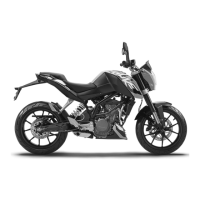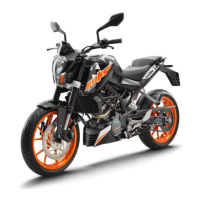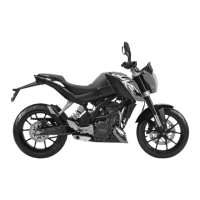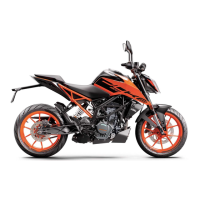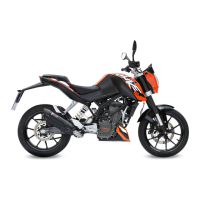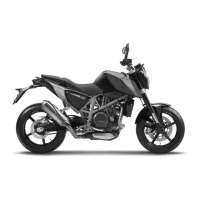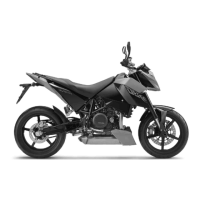16 ENGINE 126
304539-10
– Check the sealing area of the cylinder head for distortion using a straight edge and
the special tool.
Feeler gauge (59029041100) ( p. 253)
Cylinder/cylinder head - distortion of
sealing area
≤ 0.10 mm (≤ 0.0039 in)
» If the measured value does not equal the specified value:
– Change the cylinder and piston.
16.4.12 Checking the piston ring end gap (125 Duke)
304519-10
– Remove the piston ring from the piston.
– Place the piston ring in the cylinder and align it with the piston.
Guideline
Under the upper edge of the cylinder 20 mm (0.79 in)
– Measure end gap A with the special tool.
Guideline
Piston ring end gap
Compression ring ≤ 0.40 mm (≤ 0.0157 in)
Oil scraper ring ≤ 0.80 mm (≤ 0.0315 in)
Feeler gauge (59029041100) ( p. 253)
» If the end gap is more than the specified value:
– Check/measure the cylinder. ( p. 125)
» If the cylinder wear is within the tolerance range:
– Change the piston ring.
– Mount the piston ring with the marking facing toward the piston head.
16.4.13 Checking/measuring the piston (125 Duke)
304550-10
– Check the piston bearing surface for damage.
» If the piston bearing surface is damaged:
– Change the piston and, if necessary, the cylinder.
– Check that the piston rings can move easily in the piston ring grooves.
» If the piston ring is stiff:
– Clean the piston ring groove.
Tip
Use an old piston ring to clean the piston ring groove.
– Check the piston rings for damage.
» If the piston ring is damaged:
– Change the piston ring.
Info
Mount the piston ring with the marking facing upward.
– Check the piston pin for discoloration or signs of wear.
» If the piston pin has strong discoloration/signs of wear:
– Change the piston pin.
– Insert the piston pin into the connecting rod and check the bearing for play.
» If the piston pin bearing has too much play:
– Change the connecting rod and the piston pin.
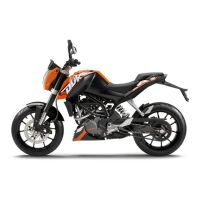
